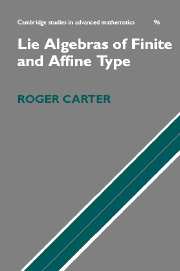Book contents
- Frontmatter
- Contents
- Preface
- 1 Basic concepts
- 2 Representations of soluble and nilpotent Lie algebras
- 3 Cartan subalgebras
- 4 The Cartan decomposition
- 5 The root system and the Weyl group
- 6 The Cartan matrix and the Dynkin diagram
- 7 The existence and uniqueness theorems
- 8 The simple Lie algebras
- 9 Some universal constructions
- 10 Irreducible modules for semisimple Lie algebras
- 11 Further properties of the universal enveloping algebra
- 12 Character and dimension formulae
- 13 Fundamental modules for simple Lie algebras
- 14 Generalised Cartan matrices and Kac–Moody algebras
- 15 The classification of generalised Cartan matrices
- 16 The invariant form, Weyl group and root system
- 17 Kac–Moody algebras of affine type
- 18 Realisations of affine Kac–Moody algebras
- 19 Some representations of symmetrisable Kac–Moody algebras
- 20 Representations of affine Kac–Moody algebras
- 21 Borcherds Lie algebras
- Appendix
- Notation
- Bibliography of books on Lie algebras
- Bibliography of articles on Kac–Moody algebras
- Index
Preface
Published online by Cambridge University Press: 25 January 2010
- Frontmatter
- Contents
- Preface
- 1 Basic concepts
- 2 Representations of soluble and nilpotent Lie algebras
- 3 Cartan subalgebras
- 4 The Cartan decomposition
- 5 The root system and the Weyl group
- 6 The Cartan matrix and the Dynkin diagram
- 7 The existence and uniqueness theorems
- 8 The simple Lie algebras
- 9 Some universal constructions
- 10 Irreducible modules for semisimple Lie algebras
- 11 Further properties of the universal enveloping algebra
- 12 Character and dimension formulae
- 13 Fundamental modules for simple Lie algebras
- 14 Generalised Cartan matrices and Kac–Moody algebras
- 15 The classification of generalised Cartan matrices
- 16 The invariant form, Weyl group and root system
- 17 Kac–Moody algebras of affine type
- 18 Realisations of affine Kac–Moody algebras
- 19 Some representations of symmetrisable Kac–Moody algebras
- 20 Representations of affine Kac–Moody algebras
- 21 Borcherds Lie algebras
- Appendix
- Notation
- Bibliography of books on Lie algebras
- Bibliography of articles on Kac–Moody algebras
- Index
Summary
Lie algebras were originally introduced by S. Lie as algebraic structures used for the study of Lie groups. The tangent space of a Lie group at the identity element has the natural structure of a Lie algebra, called by Lie the infinitesimal group. However, Lie algebras also proved to be of interest in their own right. The finite dimensional simple Lie algebras over the complex field were investigated independently by E. Cartan and W. Killing and the classification of such algebras was achieved during the decade 1890–1900. Basic ideas on the structure and representation theory of these Lie algebras were also contributed at a later stage by H. Weyl. Since then the theory of finite dimensional simple Lie algebras has found many and varied applications both in mathematics and in mathematical physics, to the extent that it is now generally regarded as one of the classical branches of mathematics.
In 1967 V. G. Kac and R. V. Moody independently introduced the Lie algebras now known as Kac–Moody algebras. The finite dimensional simple Lie algebras are examples of Kac–Moody algebras; but the theory of Kac–Moody algebras is much broader, including many infinite dimensional examples. The Kac–Moody theory has developed rapidly since its introduction and has also turned out to have applications in many areas of mathematics, including among others group theory, combinatorics, modular forms, differential equations and invariant theory. It has also proved important in mathematical physics, where it has applications to statistical physics, conformal field theory and string theory. The representation theory of affine Kac–Moody algebras has been particularly useful in such applications.
- Type
- Chapter
- Information
- Lie Algebras of Finite and Affine Type , pp. xiii - xviiiPublisher: Cambridge University PressPrint publication year: 2005

